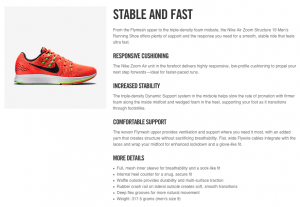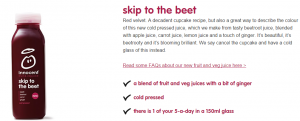Table of Contents
News flash!
Creating product descriptions isn’t just about presenting the product.
You know the drill – product specifications, price, features & product availability, all the things you heard before. But the basics put aside, there are a few more things to keep in mind.
If you want to make an impact on your customer, you should go beyond mentioning features. Lucky for you, we came up with a few tips on how to make a description worthy of your products!
While keeping the SEO in the picture, of course.
Lesson no. 1: Copycat your customers` talk
Would you believe us if we told you that your perfect description solution was in front of you all along? Well, prepare yourself ’cause here it is – write a copy in the same language your customers use!
This method will simplify the process of writing specific copies that will further motivate your customers to eagerly submit their credit card information. After that, it’s a combination of creativity and a bit of tactic that will result in good product descriptions. Let`s move on!
Creating a buyers persona doesn`t have to be dull
In essence, buyer personas are fictional portrayals of your actual customers based on real-life data. Did you know that 93% of companies who exceed lead and revenue goals segment their database by buyer persona?
But try not to think of them as the regular Jacks & Toms. Just like you, they want to get real value for their money and not spend it foolishly. Therefore, treating them as you would like to be treated as a customer is a starting point to make this step successful. Since the purpose of creating a great buyers persona is to put yourself in the shoes of the customer, it also doubles as a great way of understanding what the right type of copy (as mentioned above ↑) customers really expect from you.
After you’ve done your research on who your customers are, it is time to get into details. You can go as much in depth as you want & create a name, story, interests, family status… As you get more specific, you will find better solutions to presenting your product, so don’t hold back. You want your persona to be as real as possible.
Example: Your small sushi delivery restaurant buyer persona is called Adam. He is 32 years old. Adam is an economist & works at a government company. His favorite sport is football, which he practices with his friends twice a week. He has a long-term girlfriend, and no kids, though he is planning to have one in the future. He loves to spend evenings in, ordering sushi & watching South Park.
Do you think that’s too much? We`ll let you try it out and let us know how it goes. You`ll be surprised by the difference it makes in your restaurant SEO!
Focus on the benefits, not the features
You may wonder how the bot knows if your copy is engaging or not? Over the past few years, the algorithm has gotten smarter, but an engaging copy isn’t just about that. The longer users stay on a page, the better Google will rank its relevance. One thing to have in mind – just like you want to provide value to your customers, Google wants to do the same. So if we are all playing by the same rules – your business is happy, Google is happy, and of course – customers are happy. Benefits are ultimate ways to present your product while making your description miles better than the features one. Even though customers are interested in the features, especially when the technical products are involved, in the end, they purchase them because of the benefits. So putting them out there will double your chances of a conversion, we guarantee you.
Example: Mobile phone
Features: Camera with a 108-megapixel resolution and 100x zoom
Benefits: Create high-quality photos on the go
Readability matters
Customers approach shopping for different products in different ways.
For example, if a customer is buying a tech product, they will focus on the specifications more than they would if they are buying the beauty one. It would be best if the product specifications were separated & easier to read, and the sentences describing the product are more flexible in length. Generally, people read bullets for a longer amount of time than paragraph text, though this pattern depends on the products. Try to get a good balance of sentences, paragraphs, and bullet points to make it easier for the customer to scan it.
How much description copy do you need to write?
In a nutshell – as much as necessary. There is no magic number when it comes to product description length. It should be long enough to cover all the essentials but still short enough to keep the customers interested. However, keep in mind that meta descriptions on product pages should be 160 characters or less if you don’t want Google to sabotage them. While this all depends on the product, the rule of thumb is to use short words, sentences & short paragraphs.
4Cs for the win
The harsh truth is that no number of keywords can lead to a conversion. if it’s not written well, you won’t see the ROI. So, keep the Royal 4 in mind:
- Clarity: The descriptions should be clear enough for everyone, not just your buyer persona.
- Concise: Use fewer words to describe your products effectively and get creative!
- Compelling: Try to make your customers feel as if the product is made just for them
- Credible: The information you are sharing must be accurate and try not to “oversell”!
This product description example from Nike will put things into perspective:

The easy way to do it is to put the important information first (or write in an inverted pyramid) which means you will have to say goodbye to unnecessary or general marketing words that don’t add any real value. However, you mustn`t compromise on the information. An eCommerce study conducted by Nielsen Norman Group shows that 20% of unsuccessful purchases are due to a lack of product information, so keep that in mind.
Try to provide answers to your customer’s fears and doubts in the product description copy by considering their perspective. Maybe easier said than done, but these 4 magic Cs are the ultimate guide to bring your production description copy to another level!
Lesson no. 2: Don`t target just any SEO keywords
Keyword stuffing doesn’t help anyone, but there are other ways you can get your keywords to stand out without being penalized. It’s all about narrowing it all down to the right words, so using a solid keyword tool is crucial – whether you choose SEMrush, AHref, or Moz Keyword Explorer, finding the keywords that will highlight your product description with these tools might as well be a piece of cake.
Use the 3 types of keywords for the best results:
Informational keywords that provide information that can help customers to find solutions and answers.
Examples: Compare prices, review

Navigational keywords help customers to find info about specific products or services.
Examples: Location, social media links

Transactional keywords help navigate customers to make their purchases.
Examples: Cheapest, purchase

This approach will benefit more than just your on-site conversion optimization or SEO. Even though these types of keywords can be applied to your whole SEO strategy, try to implement them into the description to cover all the basic customer needs.
Here, you will want to narrow down the correct phrase while still paying attention to keywords’ difficulty, search volume, and related terms. And again – try to think from your customer’s perspective in order to find a perfect solution.
Place your keywords right
After you find your keywords, the next step is placement. Use the focus keywords only a few times. Yes, less is more in this case. And yes, it is enough. Using the right keywords will make it faster for your potential buyers to find your products, but there are a few places to check if you want to make it right.
The most important ones are the page’s URL, the title, the body copy & the alt image tag. And remember – no keyword stuffing!
Lesson no.3: Don’t be boring!
The last, shortest, but the most important one.
You know what you want to read so serve your customers the same respect that you demand as one. Value is the ultimate brick in building your business, so make sure to make one castle of it in your product description. And after that, reap the results!
So let`s finish it with this inspirational example from the brand Innocent:





I really love this article.